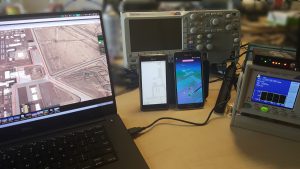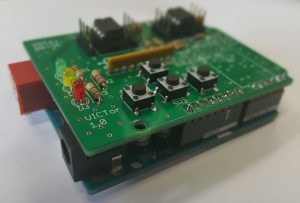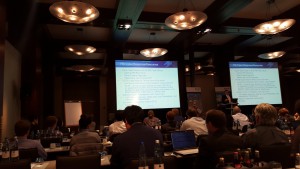Puh…it’s been a long time since my last post, huh?
However, let’s get straight back to topic. Today, I want to issue a warning, especially in face of upcoming Troopers 2017 (less than two days to go, wooo! 10th anniversary!): be careful when using wireless equipment (presenters, mouses, keyboards,…), especially during Troopers, but also in daily use. Continue reading “This is Why Your Wireless Mouse Should Have a Tail and Your Presenter is a Fail”
Author: Stefan Kiese
ITSeCX 2016: Pulling an all-nighter in Austria
Last Friday I gave a talk at the ITSeCX in St. Pölten, Austria. The conference, hosted by the local University of Applied Sciences, has already taken place ten times. I don’t know how many people attended this time, 2014 there were about 600; I read somewhere on the net. There were four tracks and some workshops from 4pm to the conference’s end at midnight. Continue reading “ITSeCX 2016: Pulling an all-nighter in Austria”
Continue readingBSides LV 2016: Recap
Hey everyone,
Just a short recap from my side regarding this year’s BSide in Las Vegas, NV. It was my first time there and I pretty much enjoyed it. After entering the venue on the first con day (Tuesday) I was a little bit shocked, as the staff sent me to the “end of the line just around the corner” – the end being many corners and many floors away 😉 Speaking to some guys while standing in line, time quickly passed by and before finally hitting the registration desk, there were already some people from the staff giving away the conference badges to the waiting folks. The waiting time was no comparison to last year’s DEF CON, where I (and obviously all the other “humans”, how attendees at DEF CON are called) had to wait nearly _four_ hours to get a badge to enter the con. DEF CON staff already calls this the annual “Line Con”. Enough bashing, back to topic 😉
The opening keynote was held by Lorrie Cranor, who spoke first and Michael Kaiser, who did the second part. I enjoyed Lorrie’s part which was about frequent password changes in environments like companies or universities. She talked about studies that revealed, many people who have to change passwords frequently use patterns by changing their passwords, like shifting letters or iterating numbers. This behavior mostly provides only a little security benefit or could otherwise also decrease security, she said.
Continue reading “BSides LV 2016: Recap”
Continue readingYour Mouse Got Sick and You Don’t Know it. aka “Reverse Shell via Mouse”
Ever got a backdoor installed on your computer by your beloved mouse? Here’s the story of a poor mouse that got really, really sick.

Do you remember the times where people put Teensy-boards and USB hubs in their mouses? [Chris? ;)] Their aim was to attach an additional Human Interface Device (HID, like keyboards or mouses) with some payload in kind of e.g. keystrokes or mouse movements. Also, there are devices available like the USB Rubber Ducky in the housing of a USB thumb drive.
The principle is easy: The tools are using a programmable microcontroller with the capability to emulate USB HID. That’s it. Just program your board of choice with the payload fitting your needs and plug it in at the target computer. The latter will recognize it as a keyboard/mouse and the payload-keystrokes will be entered.
But why should external hardware be used? Many modern gaming peripherals provide functions to store macros on them, including enough onboard memory for little payloads.
While we were working on the layout of this years’ Troopers-Badge, I felt uncomfortable using my touchpad, so I switched over to a Logitech G-series gaming mouse. This one worked like a charm – many buttons and the feature to store personal profiles on the mouse itself, which is perfect when you work on more than one machine.
But wait – macros and profiles stored on the mouse? Recall the lines above concerning the HID story.
Could it be possible to store a macro big enough to drop a reverse shell on a Windows target?
Actually – it could.
It’s just as simple as using the Logitech Gaming Software’s Command Editor. Choose a button, put a macro on it, fit the timings and go!
The only thing you should consider, that you’re limited to about 100 keystrokes. If there should be something dropped on the target, like an executable or a script, you should think about using FTP or Powershell to download it externally, like I did here.
In this Proof of Concept the marco opens the Windows Command Line and downloads Netcat via Windows’ own ftp.exe from an external FTP server. Afterwards, it launches Netcat in background mode, while a Netcat listener already is waiting on the remote machine.
I think this kind of attack is dangerous due to its minimal effort and people trusting their mouses. Who would be afraid of a manipulated mouse, while being away for just 2 minutes to grab a cold Mate drink in the kitchen? The mouse’s software in this example offers the option to delay the keystrokes. Consider, the mouse acts like usual and after 30 or 60 seconds the bad magic happens, and it would take only a few seconds, so you might even miss the chance to see the windows popping up.
Live long and prosper,
Stefan
Continue readingGotta Catch ‘Em All! – WORLDWIDE! (or how to spoof GPS to cheat at Pokémon GO)
The moment, when your team leader asks you to cheat at Pokémon GO…everyone knows it, right? No? Well, I do 😉

As I’m not a gamer, the technical part was of much more interest – that’s the real gaming for me.
So, challenge accepted!
Continue reading “Gotta Catch ‘Em All! – WORLDWIDE! (or how to spoof GPS to cheat at Pokémon GO)”
Continue readingIntroduction of a new hardware guy
Hi folks!
We couldn’t be more proud to welcome such a predestined #1 hardware hacking victim, than VICTor is!
Before Brian and I gave a lecture on hardware hacking last week at DHBW Mosbach, we felt, that we needed a custom victim which is fully documented and provides a good “hackability” to the students.
Surely we could also have used some cheap $wifi_ap, but here’s the thing: Would you really want to use a device which you don’t really know? Mostly, there’s a massive lack of documentation regarding the SoCs used…not to mention the unavailability of schematics and layouts.
As we wanted to teach students the basics of hardware hacking effectively, we decided to create something by ourselves.

Continue reading “Introduction of a new hardware guy”
Continue reading13th escar Europe conference | Embedded Security in Cars
Last week I had the pleasure to attend the “escar” (Embedded Security in Cars) conference in Cologne, Germany.
Arriving late Tuesday, I had the chance to get a rich breakfast before joining the con in the hotel Dorint at Cologne’s famous place the Heumarkt. Unfortunately I had to deal with two stumbling blocks on my way to the Dobrint: The magnetic sensor of my mobile which went crazy (no compass) and – the date. 11th of November in Cologne means just one thing – carneval! The whole city was just in a state of exception. Everybody on my way to the venue seemed to be drinking or beeing already drunk – at 9am! 😉
Being a little late, I went straight to the room after registration. As there was only one track to follow you could not miss any talk – nice thing!
After we were welcomed by the hosts, and the first talk started.

“Green Lights Forever: Analyzing the Security of Traffic Infrastructure” by Allen Hillaker
The con’s first talk was presented by Allen Hillaker. He was speaking about the security of mostly wireless traffic lights and their infrastructure in the US.
Allen presented the design of a typical traffic intersection which is connected via a radio to the road agency. He also described what happens, when a malfunction is triggered and the malfunction management unit sets the traffic lights to a well known (safe) state.
The traffic lights usually operate at 900MHz or 5.8GHz using a protocol similar to 802.11 (Wifi) without strong safety. They gathered access to the networks by using same model radio the systems at the intersections were using. As possible attacks Denial of Service, the change of the traffic lights’ timings and individual light control were named. To mitigate this, he suggested to use WPA, not broadcasting SSIDs, the use of firewalls, firmware updates and – of course – changing the default credentials. Continue reading “13th escar Europe conference | Embedded Security in Cars”
ERNW speaking @ hardwear.io

On October 1st and 2nd Flo and I were presenting at
hardwear.io in The Hague, NL. My topic was “Living in a fool’s
wireless-secured paradise” and Flo was presenting his current research
on medical device security. It was the first talk at an international
security conference for me and I am still quite excited! Continue reading “ERNW speaking @ hardwear.io”